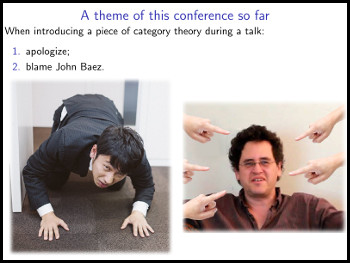Magnitude Homology in Sapporo
Posted by Tom Leinster
John and I are currently enjoying Applied Algebraic Topology 2017 in the city of Sapporo, on the northern Japanese island of Hokkaido.
I spoke about magnitude homology of metric spaces. A central concept in applied topology is persistent homology, which is also a homology theory of metric spaces. But magnitude homology is different.
It was brought into being one year ago on this very blog, principally by Mike Shulman, though Richard Hepworth and Simon Willerton had worked out a special case before. You can read a long post of mine about it from a year ago, which in turn refers back to a very long comments thread of an earlier post.
But for a short account, try my talk slides. They introduce both magnitude itself (including some exciting new developments) and magnitude homology. Both are defined in the wide generality of enriched categories, but I concentrated on the case of metric spaces.
Of course, John’s favourite slide was the one shown.
Posted at August 11, 2017 9:05 PM UTC


Re: Magnitude Homology in Sapporo
Nice slides! I’m curious what you said to accompany slides 3 and 4.
It would be nice to write up the work on magnitude homology into something publishable at some point. But it feels like before doing that we ought to plug the hole in the decategorification by finding some sense in which those formal series manipulations make sense. Also it would be nice to have more example applications along the lines of “ detects convexity”, and maybe a Kunneth or Mayer-Vietoris theorem.
I don’t really have time to be thinking about this now, but since you posted these slides I might as well ask: have you thought any more about those open problems in the past year?